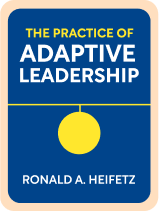

This article is an excerpt from the Shortform book guide to "The Practice of Adaptive Leadership" by Ronald A. Heifetz. Shortform has the world's best summaries and analyses of books you should be reading.
Like this article? Sign up for a free trial here .
What is adaptive leadership? What does “leading adaptively” entail in practice?
Adaptive leadership is an emerging leadership model which conceptualizes leadership as the ability to solve “adaptive challenges”—problems that have no known solutions. An adaptive leader has the ability to lead an organization through the difficult, uncomfortable, and sometimes dangerous process of adaptation, and make it thrive while doing so.
According to leadership experts Alexander Grashow, Marty Linsky, and Ronald Heifetz, there are six characteristics to consider when it comes to assessing yourself and your adaptive leadership skills.
Characteristic #1: Selves
You are a system of multiple selves, not just a single entity. In different roles and contexts, you’ll highlight different parts of your personality and skills. To effectively manage adaptive change, you need to acknowledge, accept, and be mindful of these multiple selves.
- For example, Helen, who runs a medical practice, is both a medical and business professional. If she focuses only on her medical work and ignores expenses, her business is in danger of going bankrupt. She needs to be both selves to succeed.
Acknowledging your multiple selves might feel awkward—having one self provides clarity to both you and the people you interact with. Additionally, some people feel slimy or manipulative about being different people to get things done (even though all your different selves are authentic, because they’re all still part of you). However, constraining yourself to one self erases your complexities, which has two negative consequences:
1. It’s harder to think beyond that single self. If you’re drawing only one self’s intuition and experience, you won’t be as open-minded.
2. You’re easier to predict, which can be used against you. (Shortform example: If, in every situation, you most value environmental protection, people can attack your change initiatives by bringing up the environmental consequences of them, knowing that this will make you doubt your initiative.)
Characteristic #2: Psychology
Your psychology is the combination of factors, including your genetics, culture, and childhood experiences, that shape your identity and perspective.
You respond to your surroundings based on your psychology—you’re always influenced by your circumstances and past. However, once you accept that you’re subject to influence, that’s actually when your will is most free because you can see the forces acting on you and choose how to react, rather than have your instincts take over.
- For example, if you’re unknowingly conflict-averse, you back off whenever a conversation escalates. If you’re aware of this aversion, you can recognize the instinct to back off and choose your reaction instead.
The most challenging kinds of influences are triggers—stimuli that provoke a disproportionately large reaction. There are two types of triggers to be especially mindful of:
1. Unfilled needs. Everyone needs three things: influence, affirmation, and love. A lack of any one can trigger you into a variety of unhelpful behavior.
- For example, you might have an affair with one of your colleagues if you’re lacking love.
2. Other people’s problems. If it’s in your nature to help people, whenever you see someone with a problem, you’ll be inclined to help them. Helping them is a noble goal, but if you take on too much, you’ll burn out—since the problems belong to others, not yourself, you don’t have much control over them.
- For example, if your parents were ashamed that they were poor, you can get a high-paying job and give them some money, but you can’t get rid of their shame for them—so you’ll only burn yourself out if you try.
When you’re triggered, you regress into defensive, reactive mode and lose your ability to step back and see the whole picture. Additionally, once you’ve become emotional due to a trigger, you can trigger other people, and the more authority you have, the more chaos you cause.
To notice when you’re being triggered (and use this awareness to maintain control of your emotions), watch for the following signs in yourself:
- Changes in speaking volume
- Going quiet (if normally talkative) or speaking sharply (if normally quiet)
- Pounding heart
- Sweating
- Shallow breathing
Characteristic #3: Loyalties
Loyalties are the people, groups, or ideas that you represent or are responsible for. In the previous chapter, you learned how to assess other people’s loyalties to colleagues, community, and ancestors as part of assessing their political alignment. Now, you’ll learn how to assess your own loyalties, which you’ll be able to study in more detail than other people’s, because you can get deeper into your own psyche than someone else’s. Assessing your own loyalties is important so you can see how they might be holding you back from making effective adaptive leadership decisions.
To assess your loyalties, ask yourself the following questions and subquestions:
What Are Your Important Loyalties?
It can be difficult to name the people who make up the ancestors group. Try talking to people who have the same ancestry as you, ideally your family members, but also members of identity groups you belong to, and ask them to describe how your heritage has influenced your values.
What Is the Relative Importance of Each Loyalty?
Assess how important each of your loyalties is to you by asking yourself the following questions:
- Who do you feel most accountable to?
- Whose approval do you most crave?
- Who would react the strongest to you doing something out of character?
- Who are you most scared of disappointing?
- Whose support is most important to you?
For the next 14 days, write down how much time you devote to each of the loyalty groups. The group that you give the most attention and energy is the group that you prioritize (regardless of what you say). Is it the group you thought it was?
For the next 14 days, write down how much time you devote to each individual member of the coworkers group. What does the log tell you about your priorities?
Which Loyalties Conflict?
- Ask someone to tell you about conflicts between what you say your loyalties are and what you actually spend your time and resources on.
- Think of a time when you felt conflicted about a course of action. Who were the members of the three groups (coworkers, community, and ancestors) that pulled you in different directions? How strong was their influence?
- Draw a Venn diagram to visually represent your conflicting loyalties. Draw one circle for each of the three loyalty groups and overlap the circles when different groups have the same loyalties. Use the relative size of the circles to show how important each group is, and use arrows to show in what directions the loyalties pull you.
- Gather a group of friends and ask each to pretend to be one of your loyalties (boss, mother, and so on). Get them to stand around you in a circle, the strongest loyalties closest to you. Then, ask everyone to say what they expect of you all at the same time. This will audibly represent the conflict you face from conflicting loyalties.
Loyalty and Adaptive Challenges Questionnaire
With the help of a few peers (not a boss or subordinates), go through the following exercise steps to assess how your loyalties will affect your ability to lead adaptive change. After each step, discuss your response.
1. Think of an adaptive challenge your organization is facing. List what you could do more or less of to help solve it.
- For example, Marty’s adaptive challenge was how to balance his work and life and spend more time with his family. He could leave work at 5 p.m. more often, and he could travel for work less.
2. For every list item in step #1, answer this question: “This item demonstrates loyalty to _______” (This list is the loyalties you publicly share.)
- Making time in the evenings for family demonstrated Marty’s loyalty to his family.
- Traveling for work demonstrated his loyalty to his career.
3. What loyalties from the previous question are most important? Make a list of what actions you’re engaging in that are deprioritizing these loyalties.
- Marty decided that his loyalty to his family was most important to him, but he was deprioritizing it by traveling for work (which took up a lot of time he could have spent with them).
4. For every deprioritizing action you listed in step #3, answer this question: “This action shows I’m also loyal to _____” (This is the list of loyalties you keep to yourself.)
- Marty’s work travel showed that he was loyal to his career and making money.
5. Make a list of the negative consequences that would happen if you stopped doing the deprioritizing actions on the list in step #3. This will tell you what you’re protecting yourself from.
- Marty listed losing money (and the ability to support his family) as a negative consequence of traveling less.
6. To resolve the conflicts you brought to light in this questionnaire, you’ll either have to abandon or shortchange the loyalties you listed in step #2, or risk the consequences you listed in step #5. Try conducting a small experiment to see if the consequences you fear really will happen.
- To find out if Marty really would lose money if he stopped traveling for work, he and his wife put away some money every month to represent money Marty would “lose” if he stopped traveling. After a year, they realized that having less money didn’t affect their life much. Now that Marty knew nothing bad would happen if he started turning down travel, he did so to make time for his family.
Characteristic #4: Repertoire
Your repertoire is the collection of strategies you use to promote adaptive change in either your organization or yourself. The more strategies you have, the more effective an adaptive manager you can be, because you’ll be better equipped to handle a variety of situations. Once you’ve assessed your repertoire, you can shore up weak areas if you have any.
To assess—and, if necessary, develop—your repertoire:
1. Assess your current repertoire. Ask yourself what you’re skilled at, and what you still need to work on.
2. Assess your tolerance for discomfort. Because solving adaptive challenges involves making choices that will make people angry and resistant to you, high tolerance of discomfort is one of the most important adaptive leadership skills you can develop. Ask yourself if you can act even when you’re unsure of what to do, and if you can spectate and get involved in other people’s fights without becoming uncomfortable.
Specifically, ask yourself:
- How long did your most recent uncomfortable conversation last? If it was less than three minutes, you likely have low tolerance for discomfort, and if it was longer than 30, your tolerance is probably high.
- When you’re in ambiguous or conflict-laden situations, what do you do? If you make a joke to escape the conversation, you likely have a low tolerance.
3. Increase your repertoire and tolerance using the following exercises:
- The next time you’re in an uncomfortable conversation and want to leave it, don’t take the first opportunity—wait until the second. Next time, wait until the third opportunity. (Tip: It will be easier to stick it out when the conversation is about something you’re passionate about.)
- Ask a coworker to watch you and take notes on how you react to conflict and ambiguity. Then, study her notes and look for patterns. If you always respond in the same conflict-avoidant way (for example, you always try to calm people down when they get emotional), think of some other ways you could respond and discuss these with the coworker.
Characteristic #5: Roles
Roles are parts you play to represent a value for people. (For example, someone who lobbies for equal pay for employees of all genders might represent the value of equity.)
Some of the roles you play will be assigned—to organize themselves, groups cast members into roles, often informally. (Shortform example: At your workplace, you might be the go-to person for fixing the printer.) More than one person in a group can represent the same value at the same time, and a collection of people that represent the same values is called a faction.
You have some say in how to approach the roles others try to cast you in. If you don’t like the role, you can try to get out of it, or you can take on additional roles you’re more interested in.
- For example, Byron Rushing was a politician who represented a mainly middle-class, white district with a large LBGTQ+ population. Rushing was African American and had a background in community activism, so his fellow politicians kept pushing him to advocate for low-income and disadvantaged people, which wasn’t the group he represented. He couldn’t get the other politicians to stop casting him in this role, so he decided to take it on, but also play a role that represented his constituents.
The more roles you can play, the more versatile and effective you can be because you can choose the most appropriate role for the situation. Additionally, you become more effective because you make connections with more people.
- For example, in one context, you might represent the value of level-headedness, and in another, you might represent ambition.
All of your roles are authentic, even if they’re different (or even in conflict) with each other. However, always remember that you are separate from your role. A role is a part, not a reflection of your innermost self. If something goes wrong, you’re not a failure—you just didn’t do a particular role justice. Don’t take things personally, because this will decrease your effectiveness as an adaptive leader—when you start focusing on your inner self instead of the adaptive change, the change is less likely to succeed.
If you can dissociate yourself from your role, you’ll be better able to:
- Ward off personal attacks. Personal attacks will distract you or manipulate you away from your attempts to lead adaptive change.
- Guard against flattery and idealization. Flattery, like personal attacks, can distract you from your work. Remember that it’s your work in a role, not you personally, that deserves praise.
Characteristic #6: Authority
The final characteristic to consider is your level and type of authority. There are two kinds of authority:
Type #1: Formal. This authority is explicit and well-defined. Authorizers lay out what you’re expected to do in a job description or some other explicit agreement, and you’re officially accountable to them.
Type #2. Informal. This type is implicit, unwritten, and constantly changing. Informal authorizers don’t have any hierarchical power to tell you what to do or how to do it, but they still expect you to be accountable to them.
- For example, your subordinates don’t have the power to fire you, but they have enough informal authority to get your supervisors to do it for them.
Your informal and formal authority likely don’t match up perfectly and it can be difficult to assess the boundaries of each because:
- You usually only find out you’ve exceeded a boundary when you did something you thought was within your authority and someone told you it wasn’t.
- People will deliberately give you wrong impressions of your limits. People who want to maintain the status quo will tell you you’re crossing lines even when you’re exercising appropriate authority, and people who want you to do their work or sabotage you might tell you to go farther when you’re already at the fringes.
- The boundary changes depending on circumstances. (Shortform example: It might be fine to challenge the boss about personnel matters but not about strategic decisions.)
To find the boundaries of your authority, assess how much resistance you generate. If you don’t create any, you’re probably within your scope, and if you generate a lot, you’re probably far outside it. Aim to generate a manageable amount of resistance. You can do this by challenging norms, raising tough questions, or going ahead with an experiment without authorization and then asking for forgiveness later.
Reflection Questions and Exercises
- Think about how your behavior and emotions change with changing conditions (who you’re with, what the situation is, and so on). How do you feel about these changes within yourself?
- The next time you notice yourself reacting to a trigger, wait until it comes up three times before responding so that you have a chance to control your response. (For example, if you’re triggered by being interrupted, and you’re in a meeting and someone interrupts you, wait until you’re interrupted three times before responding.)
- When you feel burned out, ask yourself if you’re carrying others’ problems and why you feel the need to do this. Then, come up with ways to give people their problems back. (For example, give it back to them piece by piece so you don’t overwhelm them.)
- Draw a pie chart that represents how much time (in percentages) you spend in each role you play in your organization. Then, draw another pie chart that shows how satisfied you are (in percentages) with each role. Do the charts look similar? Why or why not? Try playing different roles in different situations to see if you become more satisfied or effective.
- The next time your team is working on a problem, don’t let people self-assign themselves roles. Instead, name the values behind the roles and then ask the people who hold those values to identify themselves. Then, ask the people who have conflicting values to come forward. This way, the group can see the different values at play rather than automatically reaching for roles.
- Fill out the following table to get a sense of your formal and informal authority, and who your authorizers are and what their expectations are:
| Authorizer | Formal expectations | Informal expectations | What do you want to do that’s beyond the authorizer’s expectations? | Instances where you’ve encountered resistance from the authorizer |
| Supervisor | ||||
| Peers | ||||
| Reports | ||||
| External people (for example, customers) | ||||
| Partner | ||||
| Friends | ||||
| Other |
- At work, observe how people demonstrate their resistance to you and others. It may be subtle, such as making a joke about a suggestion you make. They’re probably not resisting exactly what caused their reaction—what do you think they’re really resisting? (Shortform example: If someone responds sarcastically to your suggestion to hire a co-op student, they’re probably not opposed to the student so much as how the student might inconvenience them—perhaps they think they’ll be expected to train the student.)

———End of Preview———
Like what you just read? Read the rest of the world's best book summary and analysis of Ronald A. Heifetz's "The Practice of Adaptive Leadership" at Shortform .
Here's what you'll find in our full The Practice of Adaptive Leadership summary :
- How to deal with unknown solutions that require innovation, experimentation, and adaptation
- How to determine if a problem is technical or adaptive
- Five tips for launching initiatives to address adaptive challenges






